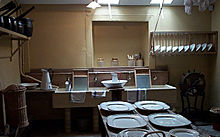Scullery
**Scullery Overview:**
– Etymology: Middle English terms squilerie, sculerie derived from Anglo-French esquilerie from Latin scutella.
– Traditional household scullery features:
– Located near water supply for easy access.
– Solid floors of brick, stone, or terracotta tiles for water handling.
– Adjacent to the kitchen with direct outdoor access.
– Sinks in pairs for hot and cold water, made of non-absorbent materials.
– Equipment included set pot, dolly tub, wooden tub, and mangle for laundry.
– Sanitation concerns:
– Risk of illness if not drained or kept clean.
– Grease in sink water leading to blockages and odors.
– Importance of proper drainage systems to prevent health hazards.
– Historical evolution of sanitation practices for improved hygiene standards.
**Hospital Sculleries:**
– Florence Nightingale’s recommendations:
– Use of porcelain sinks for hospital sculleries.
– Emphasis on new white porcelain sinks with hot and cold water.
– Prevention of foul air entering the hospital through waste pipes.
– Importance of maximum sanitation standards for patient health.
– Hygiene practices in hospital sculleries essential for patient well-being.
**References and Resources:**
– Various sources like books, articles, and online dictionaries provide information on sculleries.
– Historical texts and architectural references discuss the evolution of sculleries.
– Scholarly works and design resources shed light on the design and function of sculleries.
– Highlighting the importance of sanitation and hygiene in sculleries.
– Different perspectives and historical insights available through references.
**Educational and Research Resources:**
– Wikimedia Commons:
– Contains media related to sculleries.
– Offers visual resources for scullery research.
– Enhances understanding of historical sculleries.
– Platform for sharing scullery-related images.
– Supports educational purposes.
– Wiktionary:
– Free online dictionary defining the term ‘scullery’.
– Offers linguistic insights into scullery.
– Helps in understanding the etymology of scullery.
– Provides pronunciation guidance.
– Research Resources:
– Access to historical scullery documents.
– Enables in-depth study of scullery practices.
– Offers academic articles on sculleries.
– Provides a scholarly perspective on scullery evolution.
– Supports research on domestic history.
**Community Engagement and Educational Value:**
– Educational Value:
– Enhances knowledge of historical domestic spaces.
– Supports learning about traditional household roles.
– Offers insights into daily life in the past.
– Provides a window into historical kitchen practices.
– Facilitates educational discussions on household management.
– Community Engagement:
– Connects individuals interested in sculleries.
– Fosters a community of domestic history enthusiasts.
– Encourages sharing of scullery-related information.
– Facilitates discussions on historical household spaces.
– Promotes collaboration in researching domestic practices.
A scullery is a room in a house, traditionally used for washing up dishes and laundering clothes, or as an overflow kitchen. Tasks performed in the scullery include cleaning dishes and cooking utensils (or storing them), occasional kitchen work, ironing, boiling water for cooking or bathing, and soaking and washing clothes. Sculleries contain hot and cold sinks, sometimes slop sinks, drain pipes, storage shelves, plate racks, a work table, various coppers for boiling water, tubs, and buckets.

The term "scullery" has fallen into disuse in North America, as laundry takes place in a utility room or laundry room.
The term continues in use in its original sense in Britain and Ireland amongst the middle classes, or as an alternative term for kitchen in some regions of Britain, typically Northern Ireland, North East England and Scotland, or in designer kitchens.
In United States military facilities and most commercial restaurants, a "scullery" refers to the section of a dining facility where pots and pans are scrubbed and rinsed (in an assembly line style). It is usually near the kitchen and the serving line.
